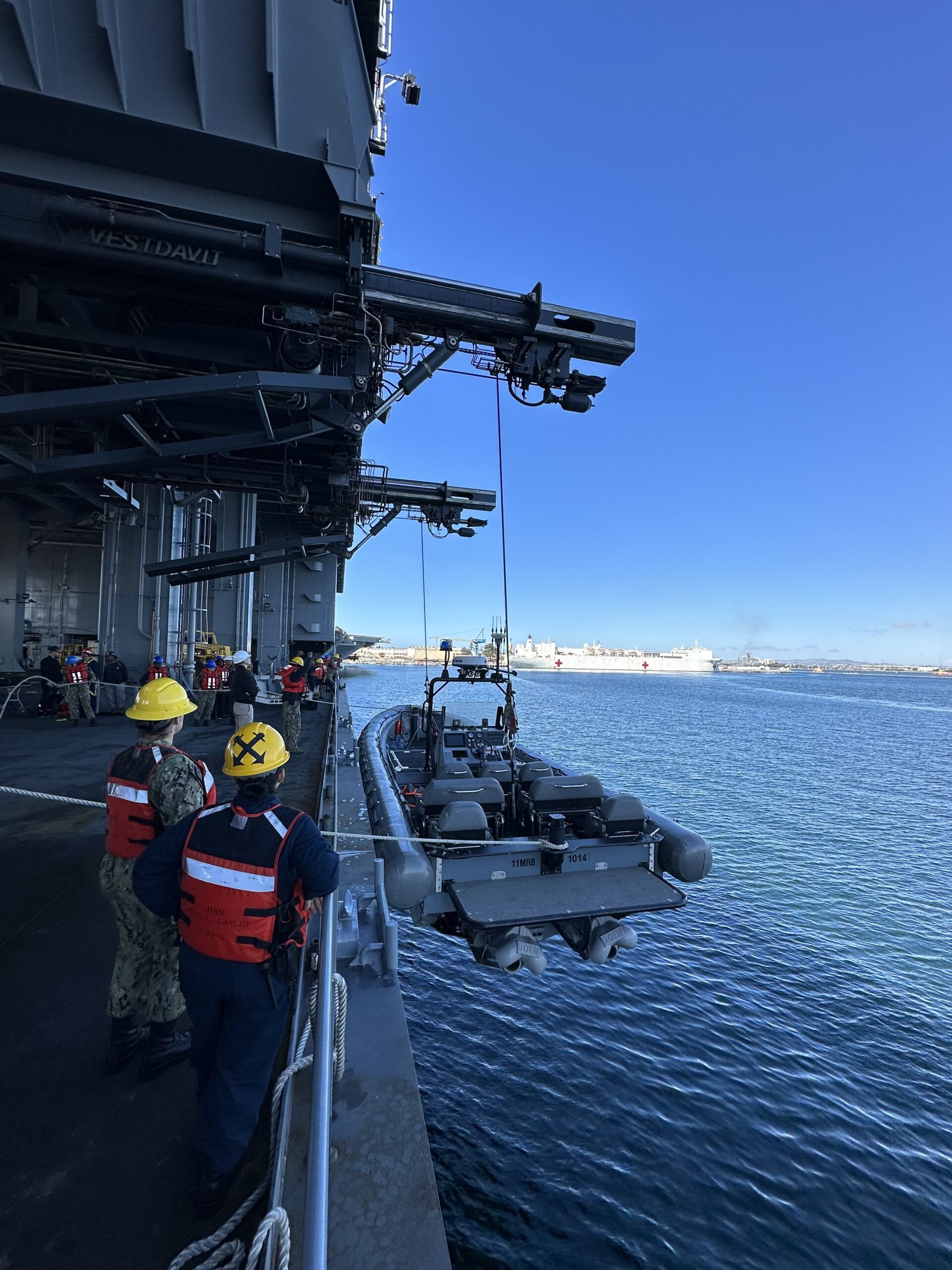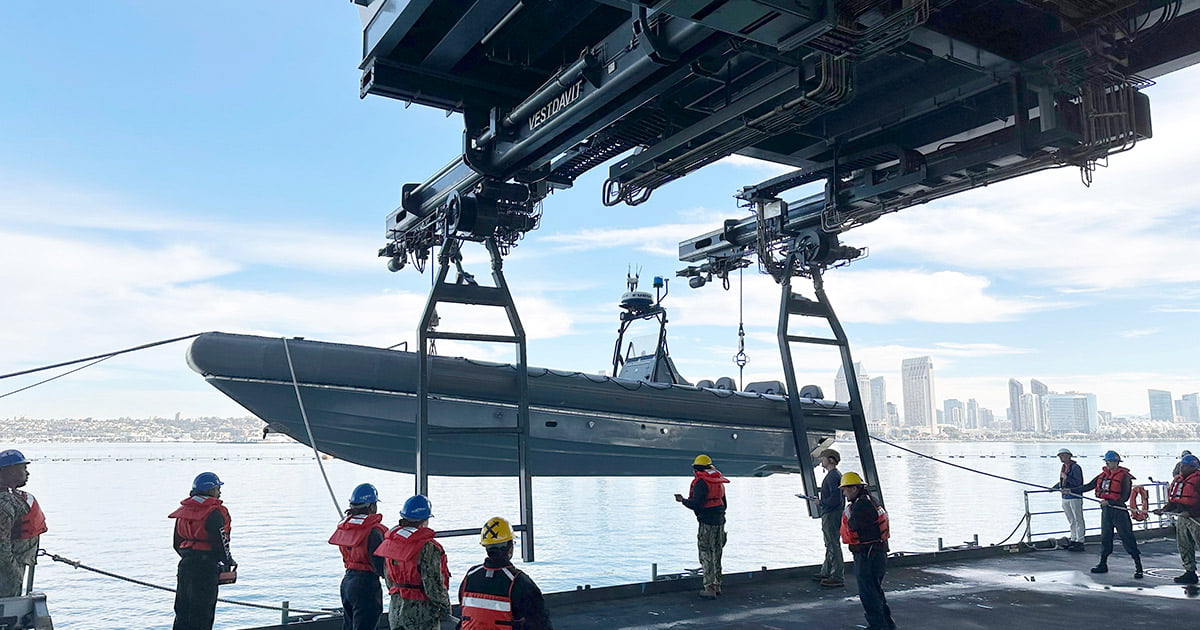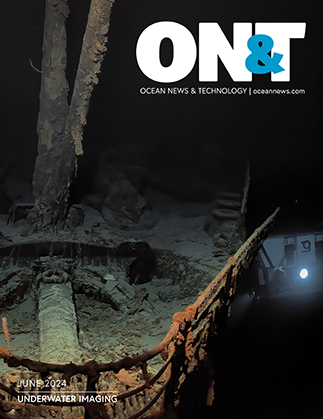Crew and davit operators serving on the newly commissioned USS John L. Canley (ESB-6) recently participated in operational training conducted by Vestdavit at a naval base in San Diego, California, to gain optimal familiarization with and knowledge of the davit system.
The naval vessel is the latest in a series of ESBs being built at San Diego-based shipyard General Dynamics NASSCO, with leading Norwegian supplier Vestdavit contracted to deliver a high-specification davit of the 2TDB-7000-type for each of three ships from ESB-6 to ESB-8.
Crew Preparedness Needed for Naval Response
The motto of the newest ESB ship is ‘Courage under fire,’ in honor of late Vietnam War veteran Sgt. Maj. John L. Canley, for whom it is named, who was awarded the US Medal of Honor for his heroic actions in saving the lives of fellow US Marines during the Battle of Hue City in 1968.
While preserving Canley’s distinguished legacy, the vessel could also be called upon to demonstrate similar warfighting readiness as it is designed to function as a highly flexible platform across diverse military operations, which makes crew preparedness of paramount importance.
Each of the ESB vessels will serve as a mobile sea base supporting critical access infrastructure for deploying forces, equipment and supplies, as well as having combat capability.
“Davit operation is an essential element of a naval ship’s response and deployment roles to carry out military missions. As well as the requirement for technical robustness and reliability to perform repetitive boat launch-and-recovery operations in rough sea conditions, human competence is an important factor to ensure the safety of personnel and equipment, so system training is key,” explains Vestdavit Inc. General Manager Magnus Oding.
“As a long-established davit supplier for navies around the world, we have therefore developed a comprehensive training program to ensure crews have the necessary expertise in operation of our systems so they are properly equipped to handle them efficiently under different conditions at sea.”

US Navy personnel undergo training by Vestdavit in the advanced davit system on USS John L. Canley at the San Diego naval base. (Image credit: Vestdavit)
Advanced Davit Features
The 2TDB-7000 overhead telescopic dual-point davits will replace a crane used on earlier delivered ESB ships and will provide enhanced capability to safely operate the davit in much higher sea states than previously. Multiple boats of various sizes and weight can be launched and recovered from the same davit, including 7 m and 11 m RHIBs, as well as the Combatant Craft Assault (CCA) to be added by the US Navy later.
The motion-compensated davit, which is hydraulically operated and has 14,000 kg SWL capacity, is the world’s most advanced of this type with the ability to operate both in dual-point and single-point configuration by switching between the different modes on the remote control.
Movement of both independent davit arms is synchronized when operating in dual-point mode and there is flexible arm spacing, which means each of the arms can be moved forward or aft to account for different lifting hook distances on the various boats that will be used, with shock absorbers on each davit arm.
The davit has a variable hoisting-and-lowering winch speed of up to 40 meters per minute, with dual independent constant tension that allows each winch to be locked separately in constant tension mode. There is also an anti-pendulation system with guide arms to stabilize launch craft.
While the system has a range of sophisticated features, it is also designed to be user-friendly and intuitive to operate using a cabled remote control, with a Programmable Logic Controller (PLC) providing automated functionality so that winches are self-levelling in both directions.
Simulating Real-Life Operations
“Our training program is therefore focused on providing detailed practical instruction in the diverse davit functions for naval crew members to give them the requisite expertise to operate correctly and take full advantage of the versatile system,” Oding says.
For the crew of the USS John L. Canley, this entailed theoretical training in the classroom and familiarization with the system’s remote control, as well as instruction in basic maintenance and discussion about procurement of recommended spare parts.
This was followed by three days of pier side operational training to gain hands-on experience, which involved dozens of launch-and-recovery sequences.
Then it was time to simulate some real-life action as the vessel took to open waters outside of San Diego where trainees performed multiple launch-and-recovery exercises in various sea states during a five-day stint that enabled them to practice using davit features such as constant tension.
Oding sees such training as an integral part of Vestdavit’s overall davit delivery package as it gains increased orders from the naval market amid a build-up of the armed forces of many countries in response to the global geopolitical situation.
“As well as providing mature technology that is well-proven in the naval sector, our ability to facilitate specialized training empowers crews with operational competence for safe boat handling when time is of the essence and lives are at stake in military situations at sea,” he concludes.

